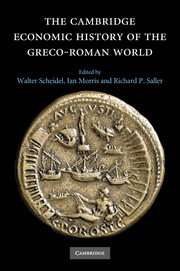Book contents
- Frontmatter
- 1 Introduction
- Part I Determinants of Economic Performance
- Part II Early Mediterranean Economies and the Near East
- Part III Classical Greece
- 12 Classical Greece: Production
- 13 Classical Greece: Distribution
- 14 Classical Greece: Consumption
- Part IV The Hellenistic States
- Part V Early Italy and the Roman Republic
- Part VI The Early Roman Empire
- Part VII Regional Development in the Roman Empire
- Part VIII Epilogue
- Bibliography
- Index
- Map 1.1 The Mediterranean basin"
- Map 10.1 Greek and Phoenician trade in the period of the Persian Wars"
- Map 11.1 The Achaemenid empire"
- Map 12.1 Greece and Asia Minor"
- Map 15.1 The Seleucid empire"
- Map 16.1 Greco-Roman Egypt"
- Map 20.1 The Roman empire at the accession of Vespasian"
- References
14 - Classical Greece: Consumption
from Part III - Classical Greece
Published online by Cambridge University Press: 28 March 2008
- Frontmatter
- 1 Introduction
- Part I Determinants of Economic Performance
- Part II Early Mediterranean Economies and the Near East
- Part III Classical Greece
- 12 Classical Greece: Production
- 13 Classical Greece: Distribution
- 14 Classical Greece: Consumption
- Part IV The Hellenistic States
- Part V Early Italy and the Roman Republic
- Part VI The Early Roman Empire
- Part VII Regional Development in the Roman Empire
- Part VIII Epilogue
- Bibliography
- Index
- Map 1.1 The Mediterranean basin"
- Map 10.1 Greek and Phoenician trade in the period of the Persian Wars"
- Map 11.1 The Achaemenid empire"
- Map 12.1 Greece and Asia Minor"
- Map 15.1 The Seleucid empire"
- Map 16.1 Greco-Roman Egypt"
- Map 20.1 The Roman empire at the accession of Vespasian"
- References
Summary
introduction
This chapter describes patterns of consumption as affected by regional productive capacities, inter-regional distribution, a range of social and geographical biases, as well as ideology and taste. Consumption is a highly symbolic activity at all social levels and due respect will be paid to interrelations between the economics and culture of consumption. I shall try, as far as it is possible, to give some quantitative assessment of standards of living in comparison to earlier and later periods. Finally, since markets and exchange supplied only a certain amount of domestic consumption, I shall ask under what conditions consumption turned into demand that affected the economy more generally.
Every analysis of consumption must face the conflict between the profligacy of social or political elites and the struggle of the poor to meet basic needs. As was argued in the previous chapters, monetization, increasing contact with the non-hellenic world, changing politics in Greek cities, and the Athenian empire had strong impacts on production and exchange after the Persian Wars. Under these circumstances, both aristocratic and peasant ways of life changed and became subject to public debates about how to live the life of a good citizen. How did these changes affect patterns of consumption both among the elite and the peasantry, and how did changes in civic ideology change the relationship between elite and peasant consumption in the fifth and fourth centuries?
- Type
- Chapter
- Information
- The Cambridge Economic History of the Greco-Roman World , pp. 385 - 406Publisher: Cambridge University PressPrint publication year: 2007
References
- 11
- Cited by



